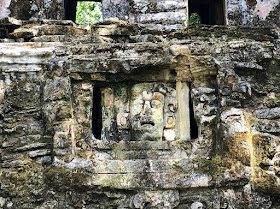 |
| Bonampak Ruins |
 |
| Lacandon Guides |
After the fantastic boat trip to Yaxchilán, we headed into the hills to the Lacandon Maya jungle and the fabulous Bonampak Murals. The Lacandon are one of the most isolated and culturally conservative of Mexico's native peoples. Almost extinct in 1943, today there are roughly 650 speakers of the Lancandon language.
Lancandon customs remain close to their pre-columbian Mesoamerican ancestors and they worship their own pantheon of ancient gods and goddesses. The Maya site of Bonampak is famous for its preserved ancient temple murals. These murals became known to the outside world when Lacondon Maya led American photographer Giles Healy to Bonampak in1946.
 |
| Maya Ruler Chaan Muan II |
Before we climbed up to see the Famed Murals we stopped and viewed Stele one, which at almost 20 feet, is among the tallest stelae in the Maya world. It represents the ruler Chaan Muan II at the height of his power in the 8th Century CE. The reason that the carving is in such good condition after all these years is that it fell face down and that protected the carved stone image.
 |
| Warriors |
Bonampak is well known for the murals that stand within the three roomed structure 1, The Temple of the Murals. The Bonampak Murals are noteworthy for debunking early ideas that the Maya were a peace loving culture of mystics. In fact the murals clearly depict war and blood sacrifice and was dedicated in 791 CE. Bonampak means Painted walls.
Archaeologists generally agree that the murals are a narrative that is to be viewed in chronological order.
 |
| Dancers |
 |
| Dancers |
Room One is a scene of tribute, dancing and musical performance.
 |
| Begging Chaan Muan II for Mercy |
Room Two is a scene of violent conflict with people people being tortured and killed while being viewed by the highest members of court and the upper echelons of the victorious force.
 |
| Fingernails Torn Out |
 |
| Intact Lintel Showing Spear in the Chest |
Room Three is a scene of a dance with observers and ritual self-blood letting.
 |
| Musicians |
 |
| Ritual Blood Letting with Sting Ray Spines |
The exterior of the Temple of the Murals, although poorly preserved, were once painted in the bright colors of Maya blue, blue-green, red and yellow. Almost everything inside and out of the temple would have bee covered in paint. Even the floors were painted black.
Considering the condition and beauty of Bonampak, it's a good idea to come and see it now before the murals decay further or are closed to visitors to protect them.
Yaxchilán and Bonampak is a wonderful adventure trip and highly recommended!
If you would like to check out more of the blog . . . Click here























































